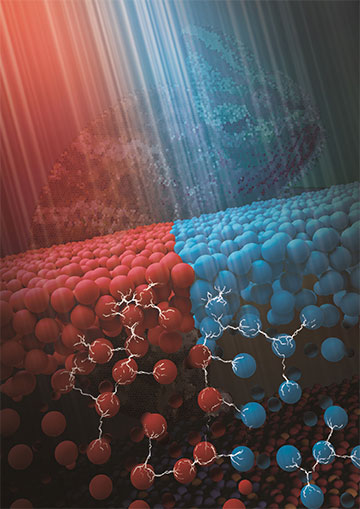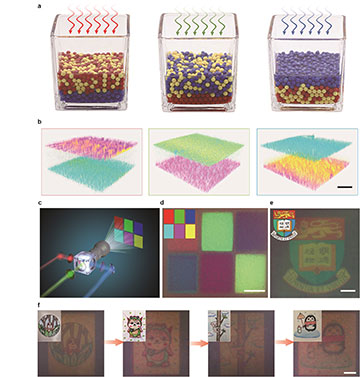
Novel ink composed of colorful microbeads responds to radiation by light-driven phase separation. [Image: The University of Hong Kong]
Inspired by the skin of cephalopods, researchers in Hong Kong have developed a new color-changing material that reversibly responds to light (Nature, doi: 10.1038/s41586-023-05873-4). The smart material is composed of photosensitive cyan, magenta and yellow microbeads that rearrange themselves to produce different pigment mixtures instead of generating new chromophores.
Possible applications for the novel technology—which is more reliable and programmable than traditional photochromic materials—include electronic ink, displays and active optical camouflage.
A colloidal swarm
Cephalopods such as octopuses and cuttlefish have the ability to change their colors and patterns in milliseconds. This incredible speed is possible because they have pigment cells known as chromatophores already stored in their skin. The animals leverage a mechanical mechanism in which pigment particles are folded or unfolded under the control of specific muscles.
Jinyao Tang and his colleagues looked to cephalopod skin when creating their unique photochromic material. It also relies on the rearrangement of existing pigment—in this case, photosensitive colloidal particles suspended in solution—rather than the production of new chromophores. Upon illumination, the colloidal swarm undergoes light-driven phase separation, leading to different color-enriched vertical layers.
“The research findings have contributed significantly to advancing our knowledge of swarm intelligence in artificial active materials and have paved the way for designing innovative active smart materials,” said study author Tang, University of Hong Kong, in a press release accompanying the research.
Programmable, reversible ink
Three-dimensional phase segregation and photochromic colloidal swarm. The top two rows illustrate spectrally sensitive, layered segregation and the 3D distribution of the colloidal system. The bottom two rows depict the process of creating images using the photochromic ink. [Image: The University of Hong Kong] [Enlarge image]
The researchers sensitized titanium dioxide colloids with spectrally distinctive dyes and then suspended them in redox shuttle solution. When the team adjusted the incident light spectra, the redox reaction on the colloids generated a chemical gradient and led to three-dimensional phase segregation. This layered stratification behavior by the colloidal swarm can be used to produce active photochromic ink.
To test the material, Tang and his colleagues increased the colloidal concentration and sealed the mixture into a parallel plate glass cell. They then projected color images from a modified commercial projector fitted with bandpass filters onto the cell to demonstrate the ink’s photochromic ability. Patterns matching images such as a university logo and various paintings were successfully recreated by the colloidal swarm, as well as easily erased and repatterned with light.
The authors write that, since the swarm is entirely self-sustained and simple to make, with further enhanced sensitivity and response time it promises a wide range of applications—from optical camouflage to smart windows for thermal management in buildings.

